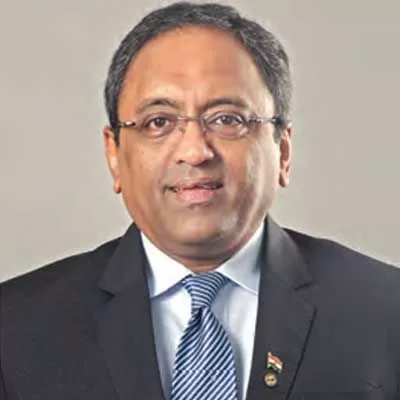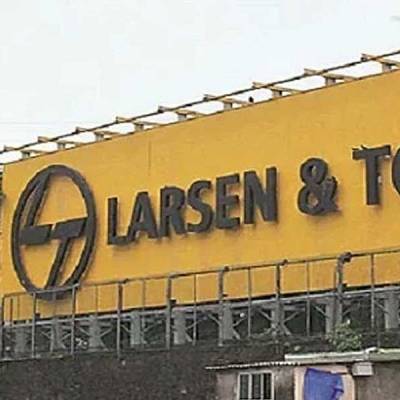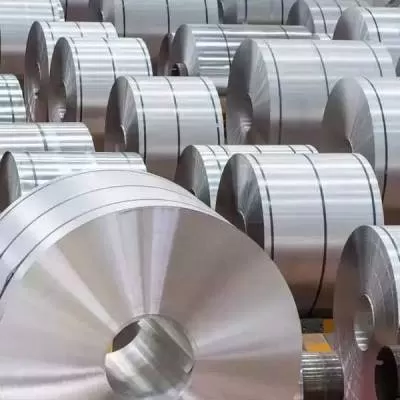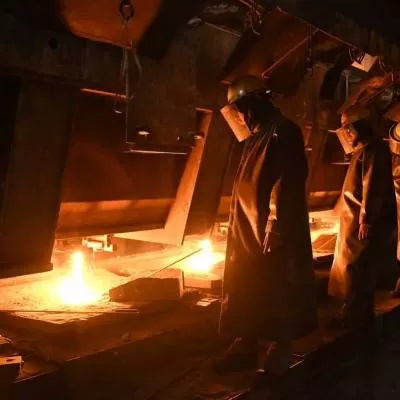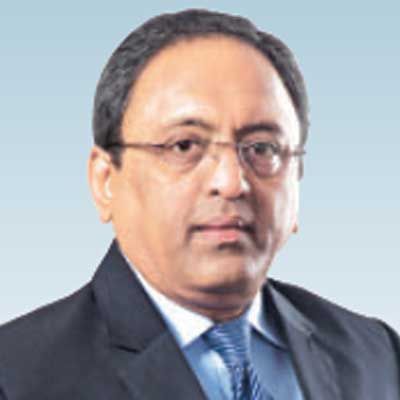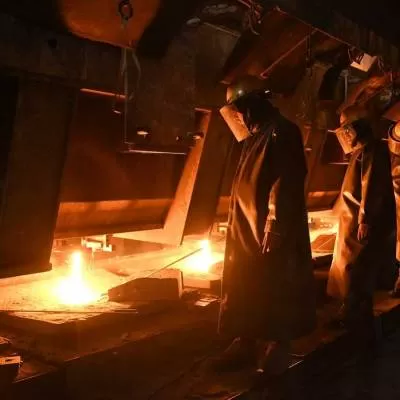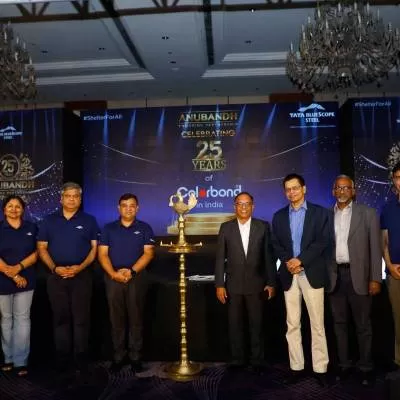- Home
- Building Material
- Steel
- Smart World Communication will be one of the fastest growing businesses within the L&T system

Smart World Communication will be one of the fastest growing businesses within the L&T system
L&T Construction ranks among the world´s top 30 contractors, contributing significantly to building L&T´s image and stature across geographies. What´s more, it is India´s largest and fastest growing construction organisation headed by SN Subrahmanyan, Deputy Managing Director & President, L&T, who has been recognised for his several significant contributions including being named the ´CONSTRUCTION WORLD Man of the Year 2015´. Beginning his career with L&T in 1984 as a project planning engineer, Subrahmanyan has risen through the ranks to reach his current position. The construction expert shares more on the company´s verticals, strategies and projects in conversation with CW Managing Director PRATAP PADODE and SHRIYAL SETHUMADHAVAN.
How do you view the current construction scenario and L&T´s business in this vertical?
L&T is a diversified conglomerate and we have invested in other businesses because we believe that the economy will soon start growing at 8-10 per cent. We have invested for concession projects through IDPL, which is one of our businesses; we have also invested in roads, ports, transmission lines and a few other areas. In ports, while we have kept away from running the operations, we continue to focus on shipbuilding and similar activities.
Our investment in roads has benefited the construction arm, although owing to the economic slowdown along with some cases of extremely competitive bidding, right-of-way issues and forest clearances, several projects have been delayed. Even in the face of these road blocks, we have more or less completed several of these projects though there are some that are not looking good from a viability perspective which, needless to say, is affecting our balance sheet. We need to be smart in deciding how to take these forward.
Our investments in shipbuilding, both in Hazira and Chennai, were with the intent to make surface and underwater ships for the Navy, but the orders have not flowed from the Navy as expected. We do, however, have some good orders for interceptor boats, fast coast guard boats, docking platforms and pre-fit ship works but these are not sufficient to generate revenues to take care of profit, depreciation and interest. We built a forge shop - a modern steel melt plant - considering the forecasted growth in the nuclear industry. Unfortunately, Fukushima happened and the Parliament passed the liability clause. Now, investors are not keen in investing with that clause but we are convinced that nuclear is the way forward and several countries such as the US, France, Japan and Russia are keen on setting up nuclear power plants in India. Hopefully, in another year or so, major organisations such as Westinghouse, GE and Hitachi will step forward and we hopefully would be one of the beneficiaries.
As for construction, we are the largest in India. We are also present in the Middle East, Africa and Far East Asia with our power transmission and distribution (PT&D) business. If the economy grows along with government investments and stalled projects get a renewed fillip, we are bound to increase our market share.
With oil prices coming down in the Middle East, are you spreading the pie to Africa and some others to fill possible gaps?
Five or six years ago, when the Indian economy was not moving at the expected pace, it was our Chairman´s insight that we should not depend on only one geography. We therefore started to focus on the Middle East and today, we have a backlog of nearly $7.5 billion there. With oil prices dropping, the revenues and GDP will get affected but many of these countries have huge sovereign funds and their debt to GDP is low. So basic infrastructure and housing will have to continue and the Middle East will therefore remain a focus area for us. However, if India develops at 8-10 per cent, we will shift our focus back because this is our main market. In PT&D, we run a billion-dollar business in India on switchyards, substations and transmissions. We also have nearly 40-per-cent market share in the Middle East. At present, we have jobs in north and east Africa too. We expect Africa to become a substantial business area for us in the next five years. Similarly, we have gone into Far East Asia with our PT&D business and have won jobs in Malaysia and are well placed in certain parts of South East Asia. Strategically, we lead with our PT&D business and once we are able to manage the local situation and economic realities of these countries, the other businesses like buildings and infrastructure will follow. In essence, we are expanding and are confident.
We want to run an organisation that delivers quality, on time with a good safety record. We want to do projects that are profitable from the point of view of our stakeholders and we want to remain a healthy organisation.
Coming to India and the prime minister´s smart cities slogan, Smart World Communications is a new area for you...
Smart World Communications has the potential to change the governance of cities and there are three parts to this business: Security solutions, communication and smart infrastructure. In the area of security solutions, we started by doing a job in the Sabarmati Jail in Gujarat. We then provided traffic violation cameras in Ahmedabad, Baroda and Gandhinagar. Thereafter, we bagged a major job for providing security cameras across Mumbai; we are doing 6,000-odd cameras. L&T Construction looks after construction, which includes providing the poles and cameras, like night-vision cameras, zoom cameras and the connectivity part. L&T Infotech provides certain software. We will have intelligent means - predictive analysis - of analysing traffic flows and patterns, behaviour of vehicles and people, and more.
For the communication business, we are already laying nearly 20,000 km of optic fibre cable for the Indian Armed Forces. There are various ways of receiving data from optic fibre such as IPLMS, DWDLMS, etc. These are basically routers, switchers, servers, network solutions, teleconference rooms, etc. We have bid for high-value tenders across the country; bagging these will take the company to the next level in communications.
For the third part of this business, smart infrastructure, we are doing our first project in central Jaipur. There are eight to nine roads and we are providing Wi-Fi, traffic management, car park management, smart kiosks and certain security solutions. It is a pilot job and if done well, along with the other contracts that we have bid for such as Bandra-Kurla and Varanasi, it could take city management to a different level. Smart World Communication will be one of the fastest growing businesses within the L&T system.
Also, how are two of the company´s major projects, Statue of Unity and the Dedicated Freight Corridor, progressing?
For the Statue of Unity project, we recently completed 4,400 cu m of concrete for the foundation and orders for the bronze and steel has been placed. We are doing a significant part - Phases I and II - on the dedicated freight corridor, which includes electrification. We are more or less on schedule and track laying is about to start. There are many more tenders for which we have quoted.
How would you comment on the current scenario in terms of aggressive bidding and how has it affected the company´s order inflows?
We bid for complicated projects. Aggression does not pay. This is a business where you commit your sales price today, see your cost work out tomorrow and then make your profits. Since we have to deal with the environment, the economy and other factors, we have to exercise extreme caution, due diligence and manage our risks well. All our projects, big or small, go through this rigor and we always bid with caution.
A lot of people say that L1 is not the right step all the time. What can be done to tweak this norm?
L1 is said to be the most efficient way of looking at a contract. Our advice to the government is to have a thorough prequalification (PQ) criteria based on technical capabilities, financial capabilities, etc, which can filter out a bulk of what is not good. Secondly, we advise the government and others in the private sector to have two methods of evaluation. Sixty per cent weightage to technical, the company´s history and track record; 40 per cent to price and have a weighted average to decide who is L1. Another method is to grade contractors. Even a small contractor is ambitious of doing a big job. So we have to go through a certain value of contracts. If a contractor has performed well for two to three jobs, then he can be allowed to go into the next value of projects and so on. So if you have to take five to 10 years to do that, you are able to elevate contractors and develop them into doing bigger contracts. This way, there need not be just one L&T; there could be 10-12, which is good for development.
Wastewater treatment is one big area. Would it be independently handled?
It is an independent billion-dollar business within the L&T system today. There are four parts to this: Water treatment and distribution; waste collection and treatment; industrial waste and lift and mega irrigation projects and desalination. This business has huge potential because we have issues of water with China, Pakistan, and between states; most of the southern states are heavily dependent on the monsoon. Then there is the Ganga cleaning programme. Many river bodies are mixed with sewage, etc. So water is a national issue. We have been successful in the Middle East too with orders from Oman, Qatar and other countries. An additional aspect of this business is operation and maintenance.
What is the agenda for skill training?
Traditionally, L&T has always placed huge emphasis on skills. There are two sides to this issue: The staff part and the labour part. On the labour part, we have eight skilled training centres and two associated centres where about 45,000 labourers are trained every year. Each business vertical has one skilled centre associated with it. Each skill centre has a small barrack where about 2,000 to 3,000 people can stay at a given point in time. We give them three to four months of rigorous training. Depending on efficiencies, we also offer training of a slightly higher order. We have been doing this for 10 years and would have trained about 300,000 to 350,000 people by now.
What do you foresee for the coming year?
We started the year with optimism because we had a new government. But many of the policy announcements have not trickled down as yet. Things are taking time because that is the way we are governed and that is how the democratic process and institutions work. Therefore, the great optimism has tempered down. However, we continue to remain cautiously optimistic.
We are doing:
One of the tallest residential towers in Mumbai, Omkar Towers.
One of the longest extra dosed bridges in India at Narmada.
One of the largest rail corridors, the dedicated freight corridor.
The Hyderabad Metro, the largest metro in the world today.
One line each of the Riyadh Metro and Doha Metro.
One-of-its-kind river development on the bank of Ganga (renovation of Ghats) in Patna.
Bringing light to millions through the APDRP kind of ruler electrification works scheme.
India´s first smart city at Jaipur.
One of the largest security solutions at Mumbai.
One of the largest Hydel projects at Bhutan.
The tallest statue in the world that of Sardar Vallabhai Patel - the Statue of Unity.
We have done India´s first 765-kv Gas Insulated Substation.
We have done one of the longest roads in the country - Beawar Pali.
We bagged one of the largest steel plant for Tata Steel at Kalinga Nagar.
We are contractors to a very big mall in Delhi, DLF Mall.
We have completed one of the largest residential complexes in Ahmedabad for Godrej.
- SN Subrahmanyan, Deputy Managing Director & President, L&T L&T Construction ranks among the world´s top 30 contractors, contributing significantly to building L&T´s image and stature across geographies. What´s more, it is India´s largest and fastest growing construction organisation headed by SN Subrahmanyan, Deputy Managing Director & President, L&T, who has been recognised for his several significant contributions including being named the ´CONSTRUCTION WORLD Man of the Year 2015´. Beginning his career with L&T in 1984 as a project planning engineer, Subrahmanyan has risen through the ranks to reach his current position. The construction expert shares more on the company´s verticals, strategies and projects in conversation with CW Managing Director PRATAP PADODE and SHRIYAL SETHUMADHAVAN. How do you view the current construction scenario and L&T´s business in this vertical? L&T is a diversified conglomerate and we have invested in other businesses because we believe that the economy will soon start growing at 8-10 per cent. We have invested for concession projects through IDPL, which is one of our businesses; we have also invested in roads, ports, transmission lines and a few other areas. In ports, while we have kept away from running the operations, we continue to focus on shipbuilding and similar activities. Our investment in roads has benefited the construction arm, although owing to the economic slowdown along with some cases of extremely competitive bidding, right-of-way issues and forest clearances, several projects have been delayed. Even in the face of these road blocks, we have more or less completed several of these projects though there are some that are not looking good from a viability perspective which, needless to say, is affecting our balance sheet. We need to be smart in deciding how to take these forward. Our investments in shipbuilding, both in Hazira and Chennai, were with the intent to make surface and underwater ships for the Navy, but the orders have not flowed from the Navy as expected. We do, however, have some good orders for interceptor boats, fast coast guard boats, docking platforms and pre-fit ship works but these are not sufficient to generate revenues to take care of profit, depreciation and interest. We built a forge shop - a modern steel melt plant - considering the forecasted growth in the nuclear industry. Unfortunately, Fukushima happened and the Parliament passed the liability clause. Now, investors are not keen in investing with that clause but we are convinced that nuclear is the way forward and several countries such as the US, France, Japan and Russia are keen on setting up nuclear power plants in India. Hopefully, in another year or so, major organisations such as Westinghouse, GE and Hitachi will step forward and we hopefully would be one of the beneficiaries. As for construction, we are the largest in India. We are also present in the Middle East, Africa and Far East Asia with our power transmission and distribution (PT&D) business. If the economy grows along with government investments and stalled projects get a renewed fillip, we are bound to increase our market share. With oil prices coming down in the Middle East, are you spreading the pie to Africa and some others to fill possible gaps? Five or six years ago, when the Indian economy was not moving at the expected pace, it was our Chairman´s insight that we should not depend on only one geography. We therefore started to focus on the Middle East and today, we have a backlog of nearly $7.5 billion there. With oil prices dropping, the revenues and GDP will get affected but many of these countries have huge sovereign funds and their debt to GDP is low. So basic infrastructure and housing will have to continue and the Middle East will therefore remain a focus area for us. However, if India develops at 8-10 per cent, we will shift our focus back because this is our main market. In PT&D, we run a billion-dollar business in India on switchyards, substations and transmissions. We also have nearly 40-per-cent market share in the Middle East. At present, we have jobs in north and east Africa too. We expect Africa to become a substantial business area for us in the next five years. Similarly, we have gone into Far East Asia with our PT&D business and have won jobs in Malaysia and are well placed in certain parts of South East Asia. Strategically, we lead with our PT&D business and once we are able to manage the local situation and economic realities of these countries, the other businesses like buildings and infrastructure will follow. In essence, we are expanding and are confident. We want to run an organisation that delivers quality, on time with a good safety record. We want to do projects that are profitable from the point of view of our stakeholders and we want to remain a healthy organisation. Coming to India and the prime minister´s smart cities slogan, Smart World Communications is a new area for you... Smart World Communications has the potential to change the governance of cities and there are three parts to this business: Security solutions, communication and smart infrastructure. In the area of security solutions, we started by doing a job in the Sabarmati Jail in Gujarat. We then provided traffic violation cameras in Ahmedabad, Baroda and Gandhinagar. Thereafter, we bagged a major job for providing security cameras across Mumbai; we are doing 6,000-odd cameras. L&T Construction looks after construction, which includes providing the poles and cameras, like night-vision cameras, zoom cameras and the connectivity part. L&T Infotech provides certain software. We will have intelligent means - predictive analysis - of analysing traffic flows and patterns, behaviour of vehicles and people, and more. For the communication business, we are already laying nearly 20,000 km of optic fibre cable for the Indian Armed Forces. There are various ways of receiving data from optic fibre such as IPLMS, DWDLMS, etc. These are basically routers, switchers, servers, network solutions, teleconference rooms, etc. We have bid for high-value tenders across the country; bagging these will take the company to the next level in communications. For the third part of this business, smart infrastructure, we are doing our first project in central Jaipur. There are eight to nine roads and we are providing Wi-Fi, traffic management, car park management, smart kiosks and certain security solutions. It is a pilot job and if done well, along with the other contracts that we have bid for such as Bandra-Kurla and Varanasi, it could take city management to a different level. Smart World Communication will be one of the fastest growing businesses within the L&T system. Also, how are two of the company´s major projects, Statue of Unity and the Dedicated Freight Corridor, progressing? For the Statue of Unity project, we recently completed 4,400 cu m of concrete for the foundation and orders for the bronze and steel has been placed. We are doing a significant part - Phases I and II - on the dedicated freight corridor, which includes electrification. We are more or less on schedule and track laying is about to start. There are many more tenders for which we have quoted. How would you comment on the current scenario in terms of aggressive bidding and how has it affected the company´s order inflows? We bid for complicated projects. Aggression does not pay. This is a business where you commit your sales price today, see your cost work out tomorrow and then make your profits. Since we have to deal with the environment, the economy and other factors, we have to exercise extreme caution, due diligence and manage our risks well. All our projects, big or small, go through this rigor and we always bid with caution. A lot of people say that L1 is not the right step all the time. What can be done to tweak this norm? L1 is said to be the most efficient way of looking at a contract. Our advice to the government is to have a thorough prequalification (PQ) criteria based on technical capabilities, financial capabilities, etc, which can filter out a bulk of what is not good. Secondly, we advise the government and others in the private sector to have two methods of evaluation. Sixty per cent weightage to technical, the company´s history and track record; 40 per cent to price and have a weighted average to decide who is L1. Another method is to grade contractors. Even a small contractor is ambitious of doing a big job. So we have to go through a certain value of contracts. If a contractor has performed well for two to three jobs, then he can be allowed to go into the next value of projects and so on. So if you have to take five to 10 years to do that, you are able to elevate contractors and develop them into doing bigger contracts. This way, there need not be just one L&T; there could be 10-12, which is good for development. Wastewater treatment is one big area. Would it be independently handled? It is an independent billion-dollar business within the L&T system today. There are four parts to this: Water treatment and distribution; waste collection and treatment; industrial waste and lift and mega irrigation projects and desalination. This business has huge potential because we have issues of water with China, Pakistan, and between states; most of the southern states are heavily dependent on the monsoon. Then there is the Ganga cleaning programme. Many river bodies are mixed with sewage, etc. So water is a national issue. We have been successful in the Middle East too with orders from Oman, Qatar and other countries. An additional aspect of this business is operation and maintenance. What is the agenda for skill training? Traditionally, L&T has always placed huge emphasis on skills. There are two sides to this issue: The staff part and the labour part. On the labour part, we have eight skilled training centres and two associated centres where about 45,000 labourers are trained every year. Each business vertical has one skilled centre associated with it. Each skill centre has a small barrack where about 2,000 to 3,000 people can stay at a given point in time. We give them three to four months of rigorous training. Depending on efficiencies, we also offer training of a slightly higher order. We have been doing this for 10 years and would have trained about 300,000 to 350,000 people by now. What do you foresee for the coming year? We started the year with optimism because we had a new government. But many of the policy announcements have not trickled down as yet. Things are taking time because that is the way we are governed and that is how the democratic process and institutions work. Therefore, the great optimism has tempered down. However, we continue to remain cautiously optimistic. We are doing: One of the tallest residential towers in Mumbai, Omkar Towers. One of the longest extra dosed bridges in India at Narmada. One of the largest rail corridors, the dedicated freight corridor. The Hyderabad Metro, the largest metro in the world today. One line each of the Riyadh Metro and Doha Metro. One-of-its-kind river development on the bank of Ganga (renovation of Ghats) in Patna. Bringing light to millions through the APDRP kind of ruler electrification works scheme. India´s first smart city at Jaipur. One of the largest security solutions at Mumbai. One of the largest Hydel projects at Bhutan. The tallest statue in the world that of Sardar Vallabhai Patel - the Statue of Unity. We have done India´s first 765-kv Gas Insulated Substation. We have done one of the longest roads in the country - Beawar Pali. We bagged one of the largest steel plant for Tata Steel at Kalinga Nagar. We are contractors to a very big mall in Delhi, DLF Mall. We have completed one of the largest residential complexes in Ahmedabad for Godrej.


